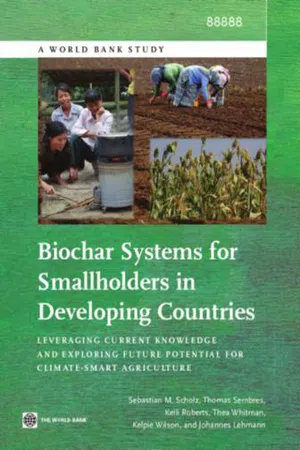
Biochar Systems for Smallholders in Developing Countries
Leveraging Current Knowledge and Exploring Future Potential for Climate-Smart Agriculture
- English
- PDF
- Available on iOS & Android
Biochar Systems for Smallholders in Developing Countries
Leveraging Current Knowledge and Exploring Future Potential for Climate-Smart Agriculture
About This Book
Biochar is the carbon-rich organic matter that remains after heating biomass under the minimization of oxygen during a process called pyrolysis. There are a number of reasons why biochar systems may be particularly relevant in developing-country contexts. This report offers a review of what is known about opportunities and risks of biochar systems. Its aim is to provide a state-of-the-art overview of current knowledge regarding biochar science. In that sense the report also offers a reconciling view on different scientific opinions about biochar providing an overall account that shows the various perspectives of its science and application. This includes soil and agricultural impacts of biochar, climate change impacts, social impacts, and competing uses of biomass. The report aims to contextualize the current scientific knowledge in order to put it at use to address the development climate change nexus, including social and environmental sustainability. The report is organized as follows: chapter one offers some introductory comments and notes the increasing interest in biochar both from a scientific and practitioner's point of view; chapter two gives further background on biochar, describing its characteristics and outlining the way in which biochar systems function. Chapter three considers the opportunities and risks of biochar systems. Based on the results of the surveys undertaken, chapter four presents a typology of biochar systems emerging in practice, particularly in the developing world. Life-cycle assessments of the net climate change impact and the net economic profitability of three biochar systems with data collected from relatively advanced biochar projects were conducted and are presented in chapter five. Chapter six investigates various aspects of technology adoption, including barriers to implementing promising systems, focusing on economics, carbon market access, and sociocultural barriers. Finally, the status of knowledge regarding biochar systems is interpreted in chapter seven to determine potential implications for future involvement in biochar research, policy, and project formulation.
Frequently asked questions
Information
Table of contents
- Front Cover
- Contents
- Acknowledgments
- About the Authors
- Abbreviations
- Executive Summary
- Chapter 1 Introduction
- Chapter 2 Background on Biochar
- Chapter 3 Opportunities and Risks of Biochar Systems
- Chapter 4 Survey and Typology of Biochar Systems
- Chapter 5 Life-Cycle Assessment of Existing Biochar Systems
- Chapter 6 Aspects of Technology Adoption
- Chapter 7 Potential Future Involvement of Development Institutions, Including the World Bank
- Appendix A Survey Results
- Appendix B Case Studies
- Appendix C Biographies: Biochar Guidance Group Members
- References
- Boxes
- Figures
- Tables
- Back Cover